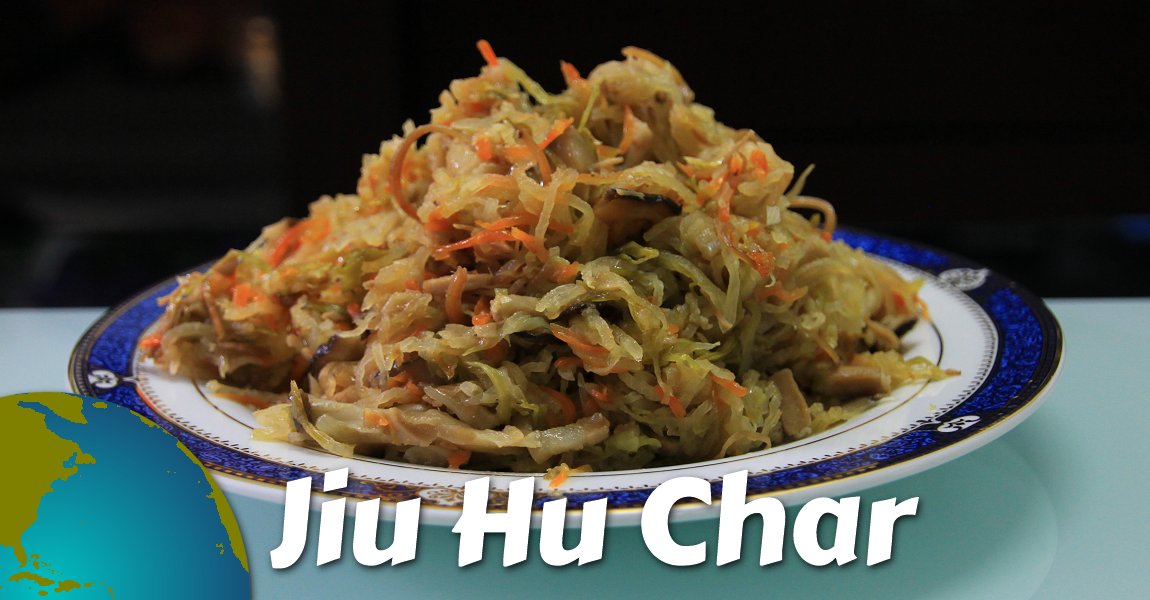 Jiu Hu Char (6 April 2013)
Jiu Hu Char (6 April 2013)
Jiu Hu Char (pronounced Jiu3 Hu3 Char4 in Penang Hokkien
 ) is a Penang Nyonya dish of stir fried vegetables with cuttlefish floss. This is the quintessential Penang local dish. Despite its name, the main ingredient of jiu hu char is not the expensive cuttlefish floss, but rather the lowly turnip, which gives the dish much of its body. However, jiu hu char without jiu3hoo3 see1 (cuttlefish floss - shredded or julienne cuttlefish) would be like chicken pie without chicken - unacceptable.
) is a Penang Nyonya dish of stir fried vegetables with cuttlefish floss. This is the quintessential Penang local dish. Despite its name, the main ingredient of jiu hu char is not the expensive cuttlefish floss, but rather the lowly turnip, which gives the dish much of its body. However, jiu hu char without jiu3hoo3 see1 (cuttlefish floss - shredded or julienne cuttlefish) would be like chicken pie without chicken - unacceptable.Everything about this dish is finely sliced, or julienned. If you are too lazy or rushed to julienne the ingredients, the alternative is to shred them with a shredder - but gourmets of local cooking would quickly point out that the taste of shredded vegetable is nowhere as tasty as julienne. Certainly shredding would have killed the texture so vital in jiu hu char.
Apart from cuttlefish floss and turnip, the other ingredients of jiu hu char include generous amounts of cabbage and carrot, followed by onions and if you wish, shiitake mushroom as well. When my wife makes jiu hu char, she also adds leek and parsley. Ah on yes, you need fatty belly pork to give it the natural oil - this is not a halal dish.
Jiu hoo char can be eaten as a starter served with Chinese lettuce, which you use to wrap the julienne vege. I find that to be too extravagant a method to consume jiu hu char - though my wife likes to eat it that way - preferring instead to have it with hot white rice.
Jiu Hu Char Recipe
Ingredients:- Pork belly aka sam chan bak - 200 gm
- Mangkuang - 2 medium sized
- Carrot - one medium
- Cabbage - half of a medium sized
- Leek - 3 medium
- Coriander - one bunch minus the leaves
- Dried shiitake mushroom - 10 medium
- Shredded cuttlefish - 50 gm - depend on how 'fragrant' you want your dish to be
- Big onion - one big or two medium
- Garlic - 1 head
- Salt - to taste
- Sugar - to taste
- Dark soy sauce - to darken the color of the dish, optional
Pork belly - boil a pot of water, enough to cover the pork belly. Once the water is boiling, put in the meat in and simmer it for 5-10 minutes. This is to remove any impurities from the meat, and also to make it easier to slice into thin slices. Shred the meat finely and put aside.
Mushroom - soak until soft. Remove the stem, and slice them fine.
Big onion - slice it fine.
Shredded cuttlefish - clean and put aside. If the strip is too long, cut into shorter lengths.
Mangkuang and carrot - remove skin, clean and grate using a medium-sized shredder. You can also use the traditional way of slicing it into julienne style (toothpick size), but this will takes a long time. Put the shredded vegetables in a colander (ka3loh4) to drain out the excess juice. The dish will be too wet if the juice is not drained. Keep the juice if you prefer a wetter dish.
Cabbage - clean and cut into thin strips, more or less like the mangkuang. For the thicker part near the base, you can remove it first, and slice into thin strips.
Leek - clean any dirt hidden between the leaves. Slice slantly into fine strips.
Coriander - remove leaves, use only the stalks. Clean the stalks, shake dry and put it on the chopping board. Use a wide blade knife to flatten the stalk. Cut into 1 inch length, and tear the stalk into fine strips.
Garlic - chop fine.
Cooking method:
- Heat up oil in a big wok. Once the oil is hot, put in the chopped garlic and sliced onion. Stir until slightly brown and aromatic.
- Add in the sliced pork belly. Stir for one minute.
- Add in the mushroom. Stirfry a while and add in the cuttlefish floss. Fry until aromatic.
- Add in the shredded mangkuang and carrot. Stirfry until the vegetables are soft. Let it simmer for 10 minutes and stir occasionally.
- Add in cabbage, leek and coriander. You can add water or the retained shredded vegetable juice if you prefer a wet dish.
- Season to taste with salt and sugar, and add a bit of dark soy sauce if you prefer a darker dish.
- Simmer until the desired texture is obtained.
- This is a dish that improves in taste with keeping. It is often prepared a day before and allow to mellow overnight in the fridge, or cooked in the morning to be served in the evening.
- Give the dish a shorter simmering time if you prefer it to be "crispier".
- You can also try adding a tablespoon of fermented soybean (tau3 cniau3) to the dish to give it an enhanced taste and a browner color.
- You can also shred the mangkuang and carrot using an electric food processor or a mandolin.
- Each household has its own recipe even though the same basic ingredients are used. Some do not add in the leek and coriander. Try and find out which recipe suites your taste.
- The quantity mentioned here is only for reference only. Adjust accordingly.
Tim & Chooi Yoke's Recipes of Homecooked Food
Let us share our recipes of homecooked food with you.Details

Copyright © 2003-2025 Timothy Tye. All Rights Reserved.


 Go Back
Go Back
